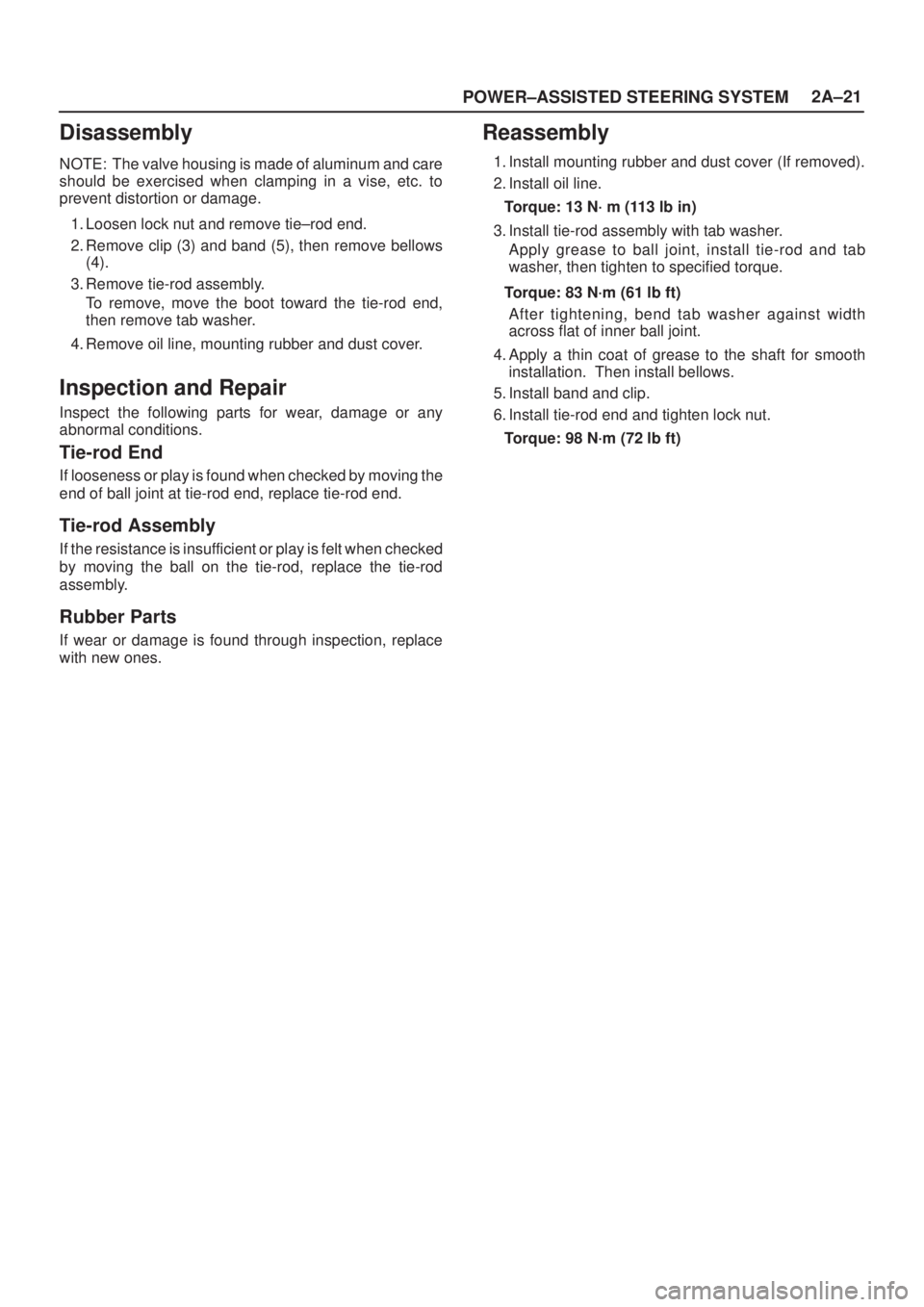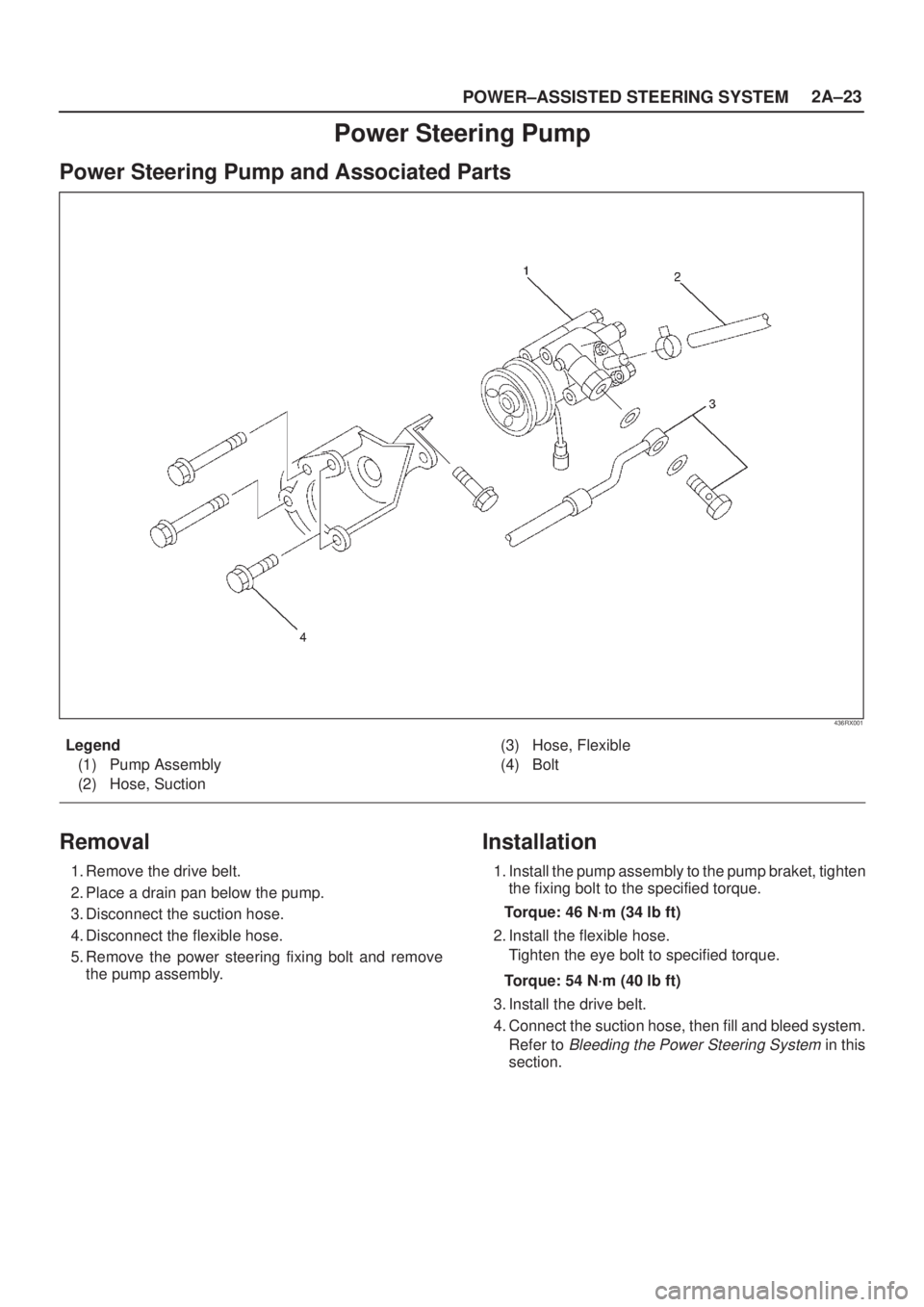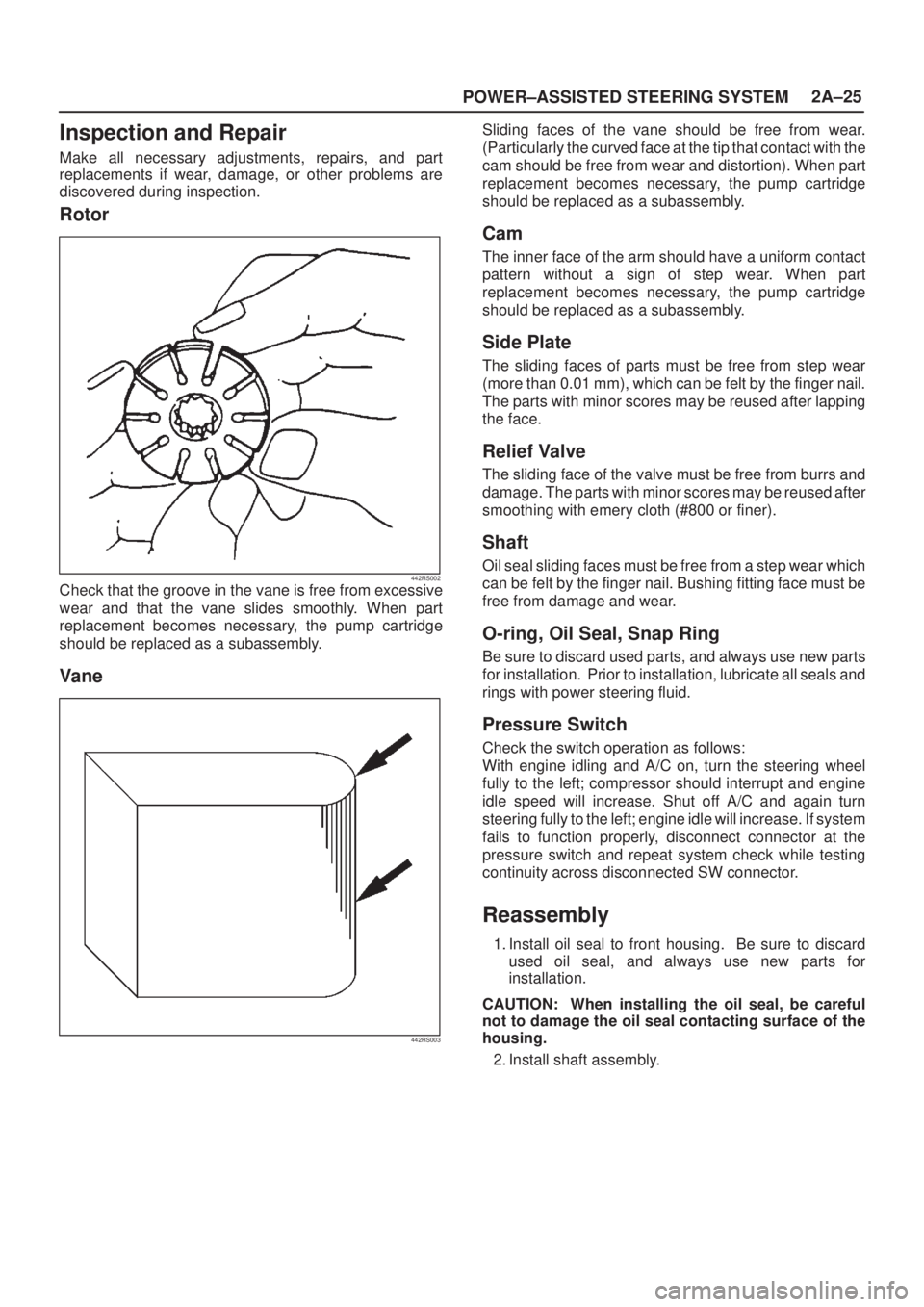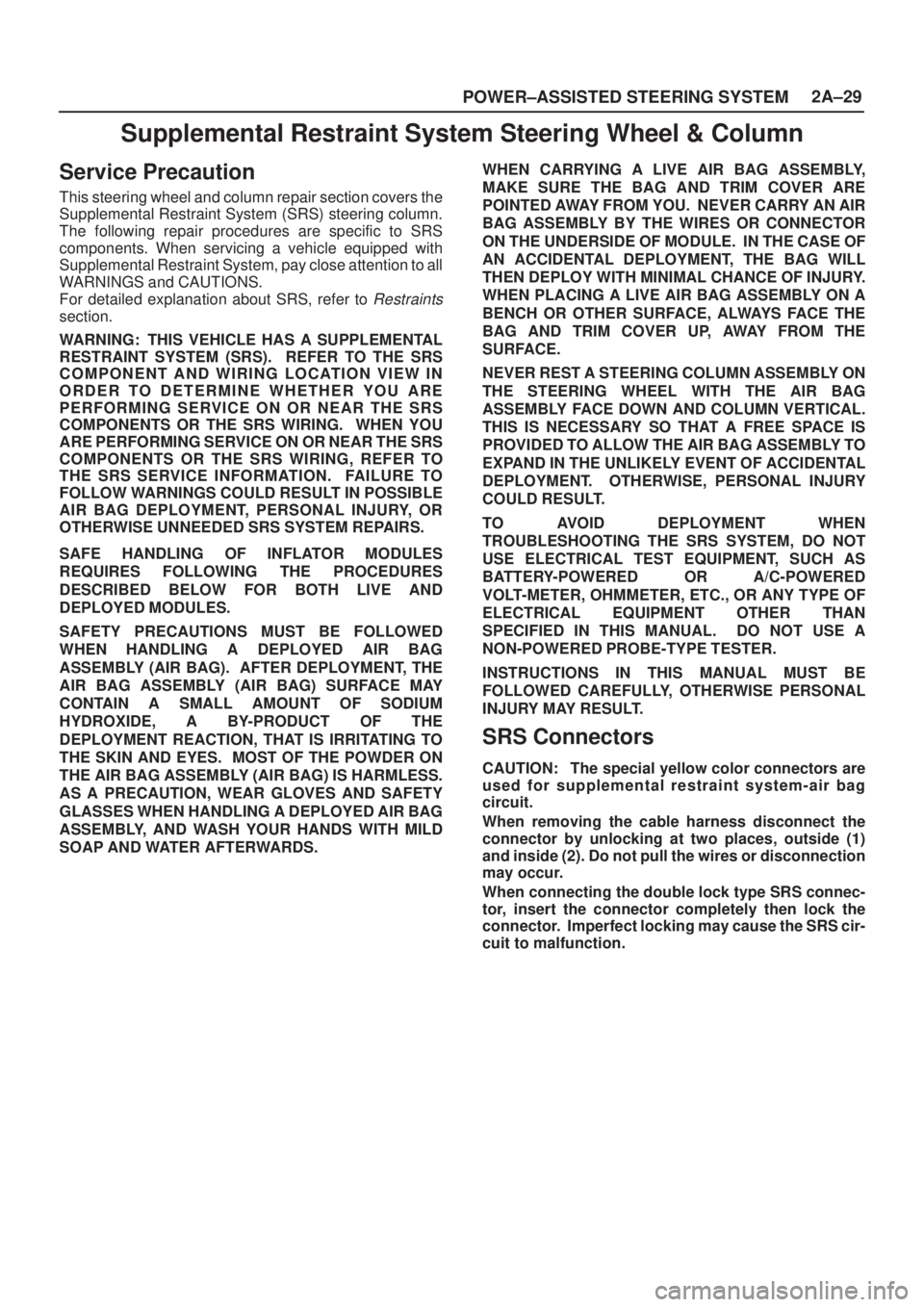ISUZU AXIOM 2002 Service Repair Manual
Manufacturer: ISUZU, Model Year: 2002, Model line: AXIOM, Model: ISUZU AXIOM 2002Pages: 2100, PDF Size: 19.35 MB
Page 171 of 2100

2A±20
POWER±ASSISTED STEERING SYSTEM
7.
a. Align the setting marks made at removal.
Install the universal joint assembly to the transfer
gear assembly.
Temporary tighten the universal joint bolt.
b. Install the universal joint assembly to the power
steering unit assembly.
Temporary tighten the universal joint bolt.
c. Install the transfer gear assembly with the shim to
frame.
Torque: 54 N´m (40 lb ft)
d. Tighten the universal joint bolt to the specified
torque.
Torque: 31 N´m (23 lb ft)8. Install the stone guard.
9. Bleed the system.
Refer to
Bleeding the Power Steering System in this
section.
Power Steering Unit Disassembled View
440R100002
Legend
(1) Tie-rod End
(2) Lock Nut
(3) Clip
(4) Bellows
(5) Band(6) Tie-rod Assembly
(7) Tab Washer
(8) Oil Line
(9) Valve Housing Assembly
(10) Mounting Rubber
(11) Dust Cover
Page 172 of 2100

POWER±ASSISTED STEERING SYSTEM2A±21
Disassembly
NOTE: The valve housing is made of aluminum and care
should be exercised when clamping in a vise, etc. to
prevent distortion or damage.
1. Loosen lock nut and remove tie±rod end.
2. Remove clip (3) and band (5), then remove bellows
(4).
3. Remove tie-rod assembly.
To remove, move the boot toward the tie-rod end,
then remove tab washer.
4. Remove oil line, mounting rubber and dust cover.
Inspection and Repair
Inspect the following parts for wear, damage or any
abnormal conditions.
Tie-rod End
If looseness or play is found when checked by moving the
end of ball joint at tie-rod end, replace tie-rod end.
Tie-rod Assembly
If the resistance is insufficient or play is felt when checked
by moving the ball on the tie-rod, replace the tie-rod
assembly.
Rubber Parts
If wear or damage is found through inspection, replace
with new ones.
Reassembly
1. Install mounting rubber and dust cover (If removed).
2. Install oil line.
Torque: 13 N´ m (113 lb in)
3. Install tie-rod assembly with tab washer.
Apply grease to ball joint, install tie-rod and tab
washer, then tighten to specified torque.
Torque: 83 N´m (61 lb ft)
After tightening, bend tab washer against width
across flat of inner ball joint.
4. Apply a thin coat of grease to the shaft for smooth
installation. Then install bellows.
5. Install band and clip.
6. Install tie-rod end and tighten lock nut.
Torque: 98 N´m (72 lb ft)
Page 173 of 2100

2A±22
POWER±ASSISTED STEERING SYSTEM
Main Data and Specifications
General Specifications
Power Steering unitTypeRack and pinion
Rack stroke152 mm (5.98 in)
Lock to lock3.64
Torque Specifications
440R100003
Special Tools
ILLUSTRATIONTOOL NO.
TOOL NAME
J±29107
Tie rod end remover
Page 174 of 2100

POWER±ASSISTED STEERING SYSTEM2A±23
Power Steering Pump
Power Steering Pump and Associated Parts
436RX001
Legend
(1) Pump Assembly
(2) Hose, Suction(3) Hose, Flexible
(4) Bolt
Removal
1. Remove the drive belt.
2. Place a drain pan below the pump.
3. Disconnect the suction hose.
4. Disconnect the flexible hose.
5. Remove the power steering fixing bolt and remove
the pump assembly.
Installation
1. Install the pump assembly to the pump braket, tighten
the fixing bolt to the specified torque.
Torque: 46 N´m (34 lb ft)
2. Install the flexible hose.
Tighten the eye bolt to specified torque.
Torque: 54 N´m (40 lb ft)
3. Install the drive belt.
4. Connect the suction hose, then fill and bleed system.
Refer to
Bleeding the Power Steering System in this
section.
Page 175 of 2100

2A±24
POWER±ASSISTED STEERING SYSTEM
Power Steering Pump Disassembled View
442RX001
Legend
(1) Bolt
(2) Suction Pipe
(3) O-ring
(4) Shaft Assembly
(5) Oil Seal
(6) Front Housing
(7) O-ring
(8) O-ring
(9) Side Plate
(10) Rotor and Vane
(11) Pin(12) Cam
(13) Pump Cartridge Assembly
(14) O-ring
(15) Snap Ring
(16) Rear Housing
(17) Bolt
(18) Spring
(19) Relief Valve
(20) O-ring
(21) Connector
(22) Pressure Switch Assembly
Disassembly
1. Clean the oil pump with solvent (plug the discharge
and suction ports to prevent the entry of solvent).
Be careful not to expose the oil seal of shaft assembly
to solvent.
2. Remove the bolt, suction pipe and O-ring.
3. Remove the connector, O-ring, relief valve and
spring.
4. Remove the pressure switch assembly.
5. Remove the bolt, rear housing and O-ring.
6. Remove the snap ring.7. Remove the shaft assembly.
8. Remove the oil seal.
CAUTION: When removing the oil seal, be careful
not to damage the housing.
9. Remove the pump cartridge assembly from the front
housing.
10. Remove two O-rings.
Page 176 of 2100

POWER±ASSISTED STEERING SYSTEM2A±25
Inspection and Repair
Make all necessary adjustments, repairs, and part
replacements if wear, damage, or other problems are
discovered during inspection.
Rotor
442RS002Check that the groove in the vane is free from excessive
wear and that the vane slides smoothly. When part
replacement becomes necessary, the pump cartridge
should be replaced as a subassembly.
Vane
442RS003
Sliding faces of the vane should be free from wear.
(Particularly the curved face at the tip that contact with the
cam should be free from wear and distortion). When part
replacement becomes necessary, the pump cartridge
should be replaced as a subassembly.
Cam
The inner face of the arm should have a uniform contact
pattern without a sign of step wear. When part
replacement becomes necessary, the pump cartridge
should be replaced as a subassembly.
Side Plate
The sliding faces of parts must be free from step wear
(more than 0.01 mm), which can be felt by the finger nail.
The parts with minor scores may be reused after lapping
the face.
Relief Valve
The sliding face of the valve must be free from burrs and
damage. The parts with minor scores may be reused after
smoothing with emery cloth (#800 or finer).
Shaft
Oil seal sliding faces must be free from a step wear which
can be felt by the finger nail. Bushing fitting face must be
free from damage and wear.
O-ring, Oil Seal, Snap Ring
Be sure to discard used parts, and always use new parts
for installation. Prior to installation, lubricate all seals and
rings with power steering fluid.
Pressure Switch
Check the switch operation as follows:
With engine idling and A/C on, turn the steering wheel
fully to the left; compressor should interrupt and engine
idle speed will increase. Shut off A/C and again turn
steering fully to the left; engine idle will increase. If system
fails to function properly, disconnect connector at the
pressure switch and repeat system check while testing
continuity across disconnected SW connector.
Reassembly
1. Install oil seal to front housing. Be sure to discard
used oil seal, and always use new parts for
installation.
CAUTION: When installing the oil seal, be careful
not to damage the oil seal contacting surface of the
housing.
2. Install shaft assembly.
Page 177 of 2100

2A±26
POWER±ASSISTED STEERING SYSTEM
3. Install the vanes to roter with curved face in contact
with the inner wall of cam.
442RS005
4. Install rotor and vanes to cam.
5. Install pin to front housing.
6. Install two new O-rings to front housing. Be sure to
discard used O-ring.
7. Install side plate.
CAUTION: When installing side plate, be careful not
to damage its inner surface. Damaged side plate may
cause poor pump performance, pump seizure or oil
leakage.
8. Install pump cartridge assembly to front housing.
9. Install snap ring to shaft end.
10. Install rear housing with a new O-ring. Be sure to
discard used O-ring. Then install bolt and tighten it to
specified torque.
Torque: 24 N´m (17 lb ft)
11. Install suction pipe with a new O-ring. Be sure to
discard used O-ring. Then install bolt and tighten it to
specified torque.
Torque: 10 N´m (87 lb in)
12. Install relief valve and spring.
13. Install connector with a new O-ring. Be sure to
discard used O-ring. Tighten the connector to
specified torque.
Torque: 59 N´m (43 lb ft)
14. Install pressure switch assembly and tighten it to
specified torque.
Torque: 18 N´m (13 lb ft)
Page 178 of 2100

POWER±ASSISTED STEERING SYSTEM2A±27
Main Data and Specifications
General Specifications
Oil pumpTypeVane
Operating
fluidATF DEXRON)±III
Torque Specifications
E02RX004
Page 179 of 2100

2A±28
POWER±ASSISTED STEERING SYSTEM
Transfer Gear Assembly
Transfer Gear Assembly and Associated Parts
441R200001
Legend
(1) Transfer Gear Assembly
(2) Bolt, Universal Joint (Steering Shaft Side)
(3) Fixing Bolt Nut(4) Shim
(5) Universal Joint Assembly
(6) Bolt, Universal Joint (Steering Unit Side)
Removal
1. Apply a setting mark across the universal joint
(steering shaft side) and transfer gear assembly to
reassemble the parts in their original position.
2. Remove universal joint bolt (steering shaft side).
3. Apply a setting mark across the universal joint
assembly and the transfer gear assembly to
reassemble the parts in their original position.
4. Remove universal joint bolts (both of transfer gear
assembly side and power steering unit assembly
side).
5. Loosen fixing bolts and nut and remove transfer gear
assembly with shim.
Inspection and Repair
The transfer gear assembly cannot be disassembled. If
damage or abnormal condition are found, replace the
entire transfer gear assembly.
Installation
1. Install the transfer gear assembly to the universal
joint (steering shaft side) align the setting marks
made at removal.
Then tighten the universal joint bolt.
2. Install the universal joint assembly to the power
steering unit assembly align the setting marks made
at removal.
Then temporary tighten the universal joint bolt (both
of transfer gear assembly side and power steering
unit assembly side).
3. Install the transfer gear assembly with the shim to
frame.
Torque: 54 N´m (40 lb ft)
4. Tighten the universal joint bolts to the specified
torque.
Torque: 31 N´m (23 lb ft)
Page 180 of 2100

POWER±ASSISTED STEERING SYSTEM2A±29
Supplemental Restraint System Steering Wheel & Column
Service Precaution
This steering wheel and column repair section covers the
Supplemental Restraint System (SRS) steering column.
The following repair procedures are specific to SRS
components. When servicing a vehicle equipped with
Supplemental Restraint System, pay close attention to all
WARNINGS and CAUTIONS.
For detailed explanation about SRS, refer to
Restraints
section.
WARNING: THIS VEHICLE HAS A SUPPLEMENTAL
RESTRAINT SYSTEM (SRS). REFER TO THE SRS
COMPONENT AND WIRING LOCATION VIEW IN
ORDER TO DETERMINE WHETHER YOU ARE
PERFORMING SERVICE ON OR NEAR THE SRS
COMPONENTS OR THE SRS WIRING. WHEN YOU
ARE PERFORMING SERVICE ON OR NEAR THE SRS
COMPONENTS OR THE SRS WIRING, REFER TO
THE SRS SERVICE INFORMATION. FAILURE TO
FOLLOW WARNINGS COULD RESULT IN POSSIBLE
AIR BAG DEPLOYMENT, PERSONAL INJURY, OR
OTHERWISE UNNEEDED SRS SYSTEM REPAIRS.
SAFE HANDLING OF INFLATOR MODULES
REQUIRES FOLLOWING THE PROCEDURES
DESCRIBED BELOW FOR BOTH LIVE AND
DEPLOYED MODULES.
SAFETY PRECAUTIONS MUST BE FOLLOWED
WHEN HANDLING A DEPLOYED AIR BAG
ASSEMBLY (AIR BAG). AFTER DEPLOYMENT, THE
AIR BAG ASSEMBLY (AIR BAG) SURFACE MAY
CONTAIN A SMALL AMOUNT OF SODIUM
HYDROXIDE, A BY-PRODUCT OF THE
DEPLOYMENT REACTION, THAT IS IRRITATING TO
THE SKIN AND EYES. MOST OF THE POWDER ON
THE AIR BAG ASSEMBLY (AIR BAG) IS HARMLESS.
AS A PRECAUTION, WEAR GLOVES AND SAFETY
GLASSES WHEN HANDLING A DEPLOYED AIR BAG
ASSEMBLY, AND WASH YOUR HANDS WITH MILD
SOAP AND WATER AFTERWARDS.WHEN CARRYING A LIVE AIR BAG ASSEMBLY,
MAKE SURE THE BAG AND TRIM COVER ARE
POINTED AWAY FROM YOU. NEVER CARRY AN AIR
BAG ASSEMBLY BY THE WIRES OR CONNECTOR
ON THE UNDERSIDE OF MODULE. IN THE CASE OF
AN ACCIDENTAL DEPLOYMENT, THE BAG WILL
THEN DEPLOY WITH MINIMAL CHANCE OF INJURY.
WHEN PLACING A LIVE AIR BAG ASSEMBLY ON A
BENCH OR OTHER SURFACE, ALWAYS FACE THE
BAG AND TRIM COVER UP, AWAY FROM THE
SURFACE.
NEVER REST A STEERING COLUMN ASSEMBLY ON
THE STEERING WHEEL WITH THE AIR BAG
ASSEMBLY FACE DOWN AND COLUMN VERTICAL.
THIS IS NECESSARY SO THAT A FREE SPACE IS
PROVIDED TO ALLOW THE AIR BAG ASSEMBLY TO
EXPAND IN THE UNLIKELY EVENT OF ACCIDENTAL
DEPLOYMENT. OTHERWISE, PERSONAL INJURY
COULD RESULT.
TO AVOID DEPLOYMENT WHEN
TROUBLESHOOTING THE SRS SYSTEM, DO NOT
USE ELECTRICAL TEST EQUIPMENT, SUCH AS
BATTERY-POWERED OR A/C-POWERED
VOLT-METER, OHMMETER, ETC., OR ANY TYPE OF
ELECTRICAL EQUIPMENT OTHER THAN
SPECIFIED IN THIS MANUAL. DO NOT USE A
NON-POWERED PROBE-TYPE TESTER.
INSTRUCTIONS IN THIS MANUAL MUST BE
FOLLOWED CAREFULLY, OTHERWISE PERSONAL
INJURY MAY RESULT.
SRS Connectors
CAUTION: The special yellow color connectors are
used for supplemental restraint system-air bag
circuit.
When removing the cable harness disconnect the
connector by unlocking at two places, outside (1)
and inside (2). Do not pull the wires or disconnection
may occur.
When connecting the double lock type SRS connec-
tor, insert the connector completely then lock the
connector. Imperfect locking may cause the SRS cir-
cuit to malfunction.